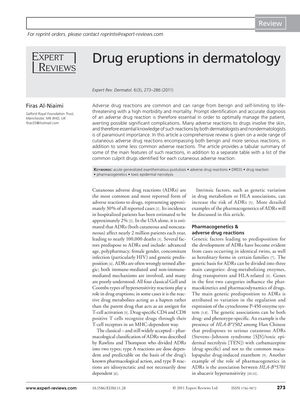TLDR Skin reactions to drugs are common and can be deadly, usually requiring stopping the drug and may be better prevented with genetic testing in the future.
The document from 2011 reviews the prevalence, diagnosis, and management of cutaneous adverse drug reactions (ADRs), which are common and can be life-threatening, affecting nearly 2 million patients annually in the USA and leading to nearly 100,000 deaths. It details various types of drug eruptions, their clinical features, and the drugs commonly responsible, emphasizing the importance of prompt identification and accurate diagnosis. The review also discusses the role of pharmacogenetics in predisposing individuals to ADRs and the necessity of drug withdrawal and supportive treatments. It covers specific drug-induced conditions, including alopecia, hirsutism, hypertrichosis, and severe reactions like Stevens-Johnson Syndrome (SJS)/Toxic Epidermal Necrolysis (TEN). The document concludes that while cutaneous ADRs are diverse, proper management typically involves the withdrawal of the offending drug, and future clinical practice may increasingly incorporate pharmacogenetics to prevent ADRs.
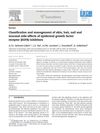 138 citations
,
February 2007 in “European journal of cancer”
138 citations
,
February 2007 in “European journal of cancer” EGFR inhibitors often cause skin problems and other side effects, but these are usually reversible and can be managed to keep patients comfortable.
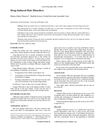 40 citations
,
August 2006 in “Current Drug Safety”
40 citations
,
August 2006 in “Current Drug Safety” Some drugs can cause hair loss, excessive growth, or color changes, often reversible but sometimes permanent.
 63 citations
,
March 1995 in “International Journal of Dermatology”
63 citations
,
March 1995 in “International Journal of Dermatology” Some drugs can cause hair loss, and stopping these drugs often leads to hair regrowth.
193 citations
,
June 1990 in “Journal of Investigative Dermatology”
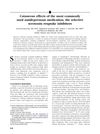 55 citations
,
December 2006 in “Journal of The American Academy of Dermatology”
55 citations
,
December 2006 in “Journal of The American Academy of Dermatology” Antidepressants called SSRIs can cause skin problems, bleeding risk, and other side effects.
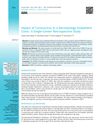 January 2021 in “Erciyes medical journal”
January 2021 in “Erciyes medical journal” The COVID-19 pandemic changed the types of skin conditions seen at a clinic, with fewer patients and varying numbers of specific conditions.

Chemotherapy can cause skin issues and hair loss, and this guide explains how to manage them.
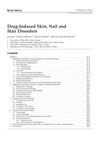 114 citations
,
January 2007 in “Drug Safety”
114 citations
,
January 2007 in “Drug Safety” Some drugs can cause skin, nail, and hair problems, which are important for healthcare professionals to recognize and report.
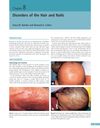 1 citations
,
January 2013 in “Elsevier eBooks”
1 citations
,
January 2013 in “Elsevier eBooks” The document reviews various hair and nail disorders, their causes, and treatments, emphasizing the need for proper diagnosis and the link between nail changes and systemic diseases.
